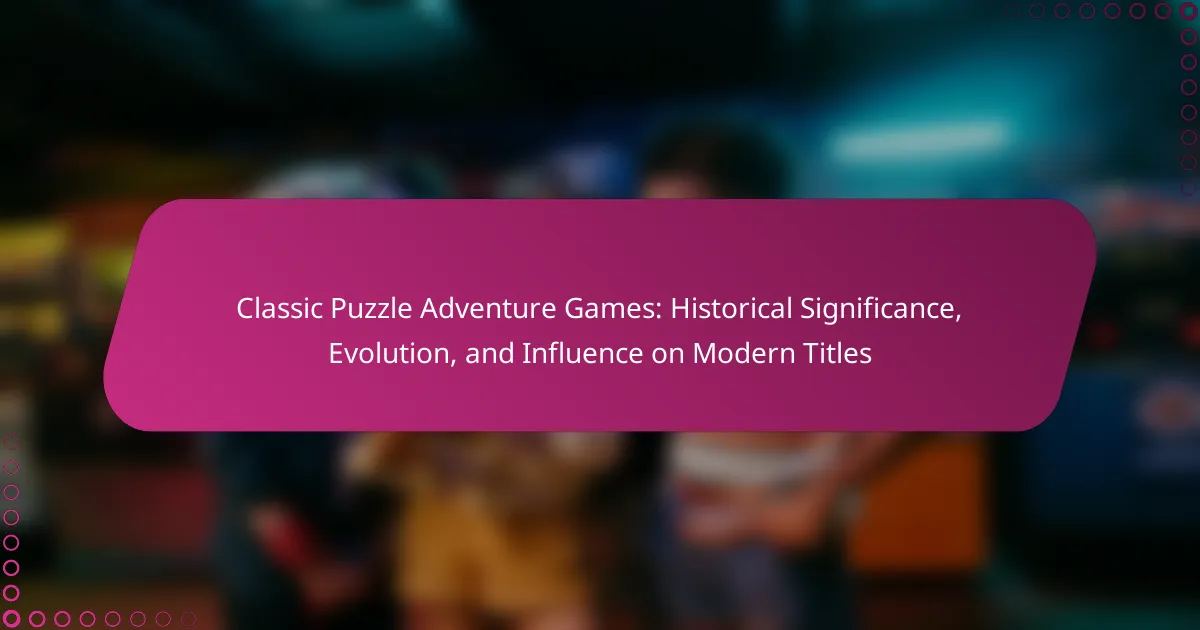Classic puzzle adventure games have shaped gaming culture by blending narrative depth with problem-solving elements. This article explores their historical significance, traces their evolution through technological advancements, and examines their lasting influence on modern titles. Notable examples like “Myst” and “Monkey Island” highlight unique attributes that continue to inspire contemporary game design. Understanding these games reveals insights into player engagement and the importance of storytelling in today’s gaming landscape.

What are the defining characteristics of classic puzzle adventure games?
Classic puzzle adventure games are defined by their immersive narratives, intricate puzzles, and exploration elements. These games often combine storytelling with problem-solving, requiring players to think critically and creatively. Key characteristics include a strong emphasis on narrative development, character interaction, and environmental puzzles that enhance engagement.
Historically significant titles like “Myst” and “Monkey Island” showcase these traits, influencing modern games by integrating rich storylines with complex gameplay mechanics. Unique attributes such as hand-drawn art styles or innovative use of inventory systems further distinguish classic titles from contemporary ones.
The evolution of these games has led to variations that maintain core gameplay while introducing new technologies and design philosophies. As a result, classic puzzle adventure games continue to inspire developers and resonate with players, highlighting their lasting impact on the gaming industry.
How do gameplay mechanics shape player experience?
Gameplay mechanics significantly shape player experience by influencing engagement, challenge, and emotional connection. Classic puzzle adventure games utilize mechanics like inventory management and environmental interaction, fostering exploration and problem-solving. These mechanics create a sense of agency, allowing players to manipulate their surroundings and progress through challenges. The evolution of these mechanics has impacted modern titles, emphasizing narrative integration and player choice. For example, contemporary games often blend puzzle-solving with storytelling, enhancing immersion and emotional investment.
What narrative elements are commonly found in these games?
Classic puzzle adventure games commonly feature narrative elements such as engaging storylines, character development, and immersive worlds. These games often include puzzles that advance the plot and reveal character backstories. Additionally, they utilize environmental storytelling, where the game world itself conveys narrative through design and interactions. The combination of these elements enhances player engagement and emotional investment in the game.

How have classic puzzle adventure games evolved over the decades?
Classic puzzle adventure games have significantly evolved, adapting to technological advancements and player expectations. Initially, these games featured simple graphics and linear narratives, focusing on logic and exploration. Over the decades, they have incorporated complex storytelling, immersive environments, and innovative mechanics, enhancing player engagement.
Notable milestones include the transition from text-based interfaces to rich graphical experiences in the 1990s, exemplified by titles like “Myst.” The rise of 3D graphics in the early 2000s brought a new dimension to gameplay, allowing for more intricate puzzles and environments. Modern titles, such as “The Witness,” showcase open-world designs and non-linear gameplay, emphasizing player choice and exploration.
The influence of classic puzzle adventure games persists in contemporary gaming, inspiring genres like escape room experiences and narrative-driven games. Their historical significance lies in shaping game design and storytelling, establishing a foundation for future innovations.
What technological advancements influenced game development?
Technological advancements significantly shaped game development, particularly in classic puzzle adventure games. Innovations such as improved graphics, sound design, and user interfaces enhanced player immersion and engagement. The introduction of personal computers and consoles expanded accessibility, allowing more players to experience these games. Additionally, advancements in programming languages and game engines facilitated more complex puzzles and narratives, influencing modern titles.
Which iconic titles marked significant milestones in the genre?
Iconic titles that marked significant milestones in classic puzzle adventure games include “Myst,” “The Secret of Monkey Island,” and “Zork.” “Myst” revolutionized the genre with its immersive 3D environments and complex puzzles. “The Secret of Monkey Island” introduced humor and engaging storytelling, setting a new standard for narrative in games. “Zork,” as an early text-based adventure, laid the groundwork for interactive storytelling and player choice. These titles significantly influenced modern puzzle adventure games by shaping gameplay mechanics and narrative structures.

What role did classic puzzle adventure games play in shaping gaming culture?
Classic puzzle adventure games significantly shaped gaming culture by introducing narrative depth and problem-solving elements. Their emphasis on exploration and interaction paved the way for modern titles. These games, like “Myst” and “The Secret of Monkey Island,” fostered community engagement through shared experiences and discussions. They also influenced game design by integrating storytelling with gameplay mechanics, encouraging developers to prioritize player agency. As a result, the legacy of classic puzzle adventure games is evident in today’s diverse gaming landscape, where narrative-driven experiences remain central.
How did they impact the design of modern video games?
Classic puzzle adventure games significantly shaped modern video game design through innovative storytelling and gameplay mechanics. Their emphasis on exploration and problem-solving laid the groundwork for narrative-driven experiences in contemporary titles. Games like “Myst” introduced immersive environments that encouraged players to think critically and engage deeply with the game world.
The evolution of these games influenced mechanics such as inventory management and puzzle-solving, which are now staples in various genres. Modern titles often incorporate complex narratives and character development, reflecting the storytelling techniques pioneered by classic puzzle adventures.
Additionally, the integration of environmental storytelling seen in these early games has become a vital design element in many current games, enhancing player immersion and engagement. Overall, the impact of classic puzzle adventure games is evident in the design philosophies that prioritize player agency and narrative depth in today’s gaming landscape.
What communities and fanbases emerged around these games?
Classic puzzle adventure games fostered vibrant communities and fanbases, significantly impacting gaming culture. Players often connect through online forums, social media, and fan sites, sharing strategies, artwork, and experiences. Notable examples include the “Myst” and “Monkey Island” communities, which celebrate nostalgia and creativity. These groups often host fan events, contributing to the ongoing evolution of the genre and influencing modern titles with their feedback and ideas.

Which unique attributes distinguish select classic puzzle adventure games?
Unique attributes that distinguish select classic puzzle adventure games include innovative narrative structures, iconic art styles, and groundbreaking gameplay mechanics. These games often feature intricate puzzles that require creative problem-solving, enhancing player engagement. Unique storytelling elements, such as branching narratives or character development, set them apart from contemporary titles. Additionally, their influence on user interface design and interactive storytelling has shaped the evolution of modern games.
What innovative storytelling techniques were introduced?
Classic puzzle adventure games introduced innovative storytelling techniques such as nonlinear narratives and immersive environments. These techniques allowed players to engage in deeper character development and plot exploration. For example, games like “Myst” utilized environmental storytelling, where the setting conveyed essential narrative elements without explicit dialogue. This approach fostered player agency, making choices impactful on the storyline. Additionally, puzzles often integrated seamlessly into the narrative, enhancing the overall experience and encouraging critical thinking. As a result, these techniques significantly influenced modern game design, emphasizing storytelling as a core gameplay element.
How do art styles and aesthetics vary among notable titles?
Art styles and aesthetics in classic puzzle adventure games reflect their historical significance and evolution. Notable titles like “Myst” and “The Secret of Monkey Island” showcase distinct visual elements that influenced modern games.
“Myst” features photorealistic graphics and immersive environments, enhancing player engagement through atmospheric storytelling. In contrast, “The Secret of Monkey Island” employs vibrant, cartoonish visuals that emphasize humor and accessibility. These contrasting aesthetics highlight the diversity in design approaches.
The evolution of these styles has led to a blend of realism and stylization in contemporary titles. Modern games often incorporate rich narratives with varying artistic influences, demonstrating the lasting impact of early classics on today’s gaming landscape.

What are some rare yet influential elements found in certain classic puzzle adventure games?
Certain classic puzzle adventure games feature rare elements that significantly influenced the genre. One example is “The Secret of Monkey Island,” which introduced humor and narrative depth, setting a benchmark for storytelling. Another is “Myst,” known for its atmospheric graphics and non-linear gameplay, which inspired exploration-focused designs in modern titles. “Grim Fandango” utilized a unique art style and complex puzzles, blending film noir with adventure gaming, influencing visual storytelling. Lastly, “The Legend of Zelda: Ocarina of Time” pioneered 3D puzzle mechanics, impacting countless subsequent games with its innovative approach to exploration and problem-solving.
How did cultural references enhance gameplay and immersion?
Cultural references significantly enhance gameplay and immersion by creating relatable contexts for players. They evoke nostalgia, connect players to familiar narratives, and enrich the storytelling experience. Classic puzzle adventure games often incorporate historical figures, literature, and pop culture, making the gameplay more engaging. For example, references to famous artworks or literary works deepen players’ emotional investment, fostering a sense of exploration and discovery. This layered storytelling has influenced modern titles, which continue to utilize cultural elements to create immersive worlds.
What experimental features were introduced in lesser-known titles?
Experimental features in lesser-known classic puzzle adventure games include innovative mechanics and narrative techniques. For example, “The Last Express” introduced real-time gameplay, affecting player choices and outcomes. “The Secret of Monkey Island” incorporated humor and meta-commentary, influencing future storytelling. “Grim Fandango” utilized 3D graphics in a traditionally 2D genre, showcasing a shift in visual presentation. These titles paved the way for modern games by blending traditional puzzles with evolving gameplay dynamics.

How can modern developers learn from classic puzzle adventure games?
Modern developers can learn from classic puzzle adventure games by analyzing their narrative techniques, puzzle design, and player engagement strategies. These games often prioritize storytelling, creating immersive worlds that captivate players. The evolution of game mechanics shows how challenges can be balanced with rewards, enhancing player satisfaction. Influences from classics like “Myst” and “Monkey Island” are evident in modern titles, which borrow elements such as exploration and problem-solving. Additionally, the unique attribute of player agency in decision-making found in these classics shapes current game design, fostering deeper connections between players and narratives.
What best practices can be applied in game design today?
Classic puzzle adventure games should prioritize player engagement through immersive storytelling and challenging gameplay. Focus on intuitive controls, seamless puzzles, and rich visuals to enhance the experience. Incorporate feedback mechanisms to guide players without frustration. Additionally, ensure accessibility for diverse audiences, allowing for broader enjoyment and participation. Emphasizing community feedback can also refine game design and foster loyalty.
What common pitfalls should be avoided when developing puzzle adventure games?
Common pitfalls in developing puzzle adventure games include neglecting player feedback, overcomplicating puzzles, and failing to balance challenge with accessibility. Developers should ensure puzzles are intuitive and offer hints to avoid frustration. Additionally, a cohesive narrative enhances engagement, while inconsistent art styles can distract players.




